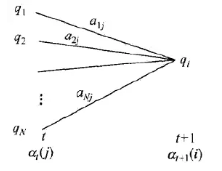一、简介
隐马尔可夫模型(Hidden Markov model, HMM)是一种结构最简单的动态贝叶斯网的生成模型,它也是一种著名的有向图模型。它是典型的自然语言中处理标注问题的统计机器学模型,本文将重点介绍这种经典的机器学习模型。
1 引言
假设有三个不同的骰子(6面、4面、8面),每次先从三个骰子里面选择一个,每个骰子选中的概率为1/3,如下图所示,重复上述过程,得到一串数值[1,6,3,5,2,7]。这些可观测变量组成可观测状态链。同时,在隐马尔可夫模型中还有一条由隐变量组成的隐含状态链,在本例中即骰子的序列。比如得到这串数字骰子的序列可能为[D6, D8, D8, D6, D4, D8]。

隐马尔可夫型示意图如下所示:

图中,箭头表示变量之间的依赖关系。图中各箭头的说明如下:

在任意时刻,观测变量(骰子)仅依赖于状态变量(哪类骰子),同时t时刻的状态qt仅依赖于t-1时刻的状态qt-1。这就是马尔科夫链,即系统的下一时刻仅由当前状态(无记忆),即“齐次马尔可夫性假设”
2 隐马尔可夫模型的定义
根据上面的例子,这里给出隐马尔可夫的定义。隐马尔科夫模型是关于时序的概率模型,描述由一个隐藏的马尔可夫链随机生成不可观测的状态随机序列,再由各个状态生成一个可观测的随机序列的过程,隐藏的马尔可夫链随机生成的状态序列,称为状态序列(也就上面例子中的D6,D8等);每个状态生成一个观测,而由此产生的观测随机序列,称为观测序列(也就上面例子中的1,6等)。序列的每个位置又可以看作是一个时刻。
隐马尔可夫模型由初始的概率分布、状态转移概率分布以及观测概率分布确定。具体的形式如下,这里设Q是所有可能的状态的集合,V是所有可能的观测的集合,即有:



3 前向算法


对于步骤一的初始,是初始时刻的状态i1 = q1和观测o1的联合概率。步骤(2) 是前向概率的递推公式,计算到时刻t+1部分观测序列为o1,o2,…,ot,ot+1 且在时刻t+1处于状态qi的前向概率。如上图所示,既然at(j)是得到时刻t观测到o1,o2,…,ot并在时刻t处于状态的qj前向概率,那么at(j)aji就是到时刻t观测到o1,o2,…,ot并在是时刻t处于qj状态而在时刻t+1到达qi状态的联合概率。对于这个乘积在时刻t的所有可能的N个状态求和,其结果就是到时刻t观测为o1,o2,…,ot,并在时刻t+1处于状态qi的联合概率。最后第三步,计算出P(O|lamda)的结果。
当然这里只是介绍了诸多算法中的一种,类似的还有后向算法(大家可以看相关的书籍进行了解)。对于动态规划的解决隐马尔科夫模型预测问题,应用最多的是维特比算法。
二、源代码
function varargout = SleepStatus(varargin)
% SLEEPSTATUS MATLAB code for SleepStatus.fig
% SLEEPSTATUS, by itself, creates a new SLEEPSTATUS or raises the existing
% singleton*.
%
% H = SLEEPSTATUS returns the handle to a new SLEEPSTATUS or the handle to
% the existing singleton*.
%
% SLEEPSTATUS('CALLBACK',hObject,eventData,handles,...) calls the local
% function named CALLBACK in SLEEPSTATUS.M with the given input arguments.
%
% SLEEPSTATUS('Property','Value',...) creates a new SLEEPSTATUS or raises the
% existing singleton*. Starting from the left, property value pairs are
% applied to the GUI before SleepStatus_OpeningFcn gets called. An
% unrecognized property name or invalid value makes property application
% stop. All inputs are passed to SleepStatus_OpeningFcn via varargin.
%
% *See GUI Options on GUIDE's Tools menu. Choose "GUI allows only one
% instance to run (singleton)".
%
% See also: GUIDE, GUIDATA, GUIHANDLES
% Edit the above text to modify the response to help SleepStatus
% Last Modified by GUIDE v2.5 21-Oct-2020 17:16:55
% Begin initialization code - DO NOT EDIT
gui_Singleton = 1;
gui_State = struct('gui_Name', mfilename, ...
'gui_Singleton', gui_Singleton, ...
'gui_OpeningFcn', @SleepStatus_OpeningFcn, ...
'gui_OutputFcn', @SleepStatus_OutputFcn, ...
'gui_LayoutFcn', [] , ...
'gui_Callback', []);
if nargin && ischar(varargin{
1})
gui_State.gui_Callback = str2func(varargin{
1});
end
if nargout
[varargout{
1:nargout}] = gui_mainfcn(gui_State, varargin{
:});
else
gui_mainfcn(gui_State, varargin{
:});
end
% End initialization code - DO NOT EDIT
% --- Executes just before SleepStatus is made visible.
function SleepStatus_OpeningFcn(hObject, eventdata, handles, varargin)
% This function has no output args, see OutputFcn.
% hObject handle to figure
% eventdata reserved - to be defined in a future version of MATLAB
% handles structure with handles and user data (see GUIDATA)
% varargin command line arguments to SleepStatus (see VARARGIN)
% Choose default command line output for SleepStatus
handles.output = hObject;
set(handles.text2,'string','Sleep status detector','foregroundcolor','b','fontsize',20);
set(handles.pushbutton1,'String','打开文件');
set(handles.pushbutton2,'String','播放且判断');
set(handles.pushbutton3,'String','停止');
set(handles.edit1,'String','实时判断结果');
set(handles.edit2,'String','过往判断结果');
set(handles.edit2,'Max',10);
set(handles.edit2,'Min',0);
cla(handles.axes1);
cla(handles.axes2);
global player timer_counter accurate_time n_last n_last1 all_result num
player=[];
timer_counter =0;
accurate_time = 0;
n_last =2;
n_last1 =2;
num =1;
all_result={
};
% Update handles structure
guidata(hObject, handles);
% UIWAIT makes SleepStatus wait for user response (see UIRESUME)
% uiwait(handles.figure1);
% --- Outputs from this function are returned to the command line.
function varargout = SleepStatus_OutputFcn(hObject, eventdata, handles)
% varargout cell array for returning output args (see VARARGOUT);
% hObject handle to figure
% eventdata reserved - to be defined in a future version of MATLAB
% handles structure with handles and user data (see GUIDATA)
% Get default command line output from handles structure
varargout{
1} = handles.output;
% --- Executes on button press in pushbutton1.
function pushbutton1_Callback(hObject, eventdata, handles)
% hObject handle to pushbutton1 (see GCBO)
% eventdata reserved - to be defined in a future version of MATLAB
% handles structure with handles and user data (see GUIDATA)
global wavfilename timer_counter all_result num
[FileName,PathName] = uigetfile('*.wav','Select the wav-file');
if FileName==0
wavfilename =[];
return
end
wavfilename = [PathName,FileName];
[x,fs] = audioread(wavfilename);
x = mean(x,2);
axes(handles.axes1);
plot(x);
ylim([-1 1]);
timer_counter = 0;
accurate_time =0;
all_result={
};
set(handles.edit2,'string','');
num = 1;
% --- Executes on button press in pushbutton2.
function pushbutton2_Callback(hObject, eventdata, handles)
% hObject handle to pushbutton2 (see GCBO)
% eventdata reserved - to be defined in a future version of MATLAB
% handles structure with handles and user data (see GUIDATA)
global wavfilename tAxis player myStruct start_minute start_seconds
if isempty(wavfilename)
return
end
%default
durT = 30*60; %seconds
fs = 32000;
durS = fs*durT; %samples
[x,fs] = audioread(wavfilename);
x = mean(x,2);
durT = size(x,1)/fs;
durS = size(x,1);
dt = 1/fs;
tAxis = dt:dt:durT;
frameRate = 25; %fps
frameT = 1/frameRate;
mag = 1;
axes(handles.axes1);
cla(handles.axes1);
plot(tAxis, x);
ylim([-mag mag])
xlim([0 durT])
xlabel('Time [s]')
playHeadLoc = 0;
% hold on;
ax = plot([0 playHeadLoc], [-mag mag], 'r', 'LineWidth', 2);
player = audioplayer(x, fs);
myStruct.playHeadLoc = playHeadLoc;
myStruct.frameT = frameT;
myStruct.ax1 = handles.axes1;
myStruct.ax2 = handles.axes2;
myStruct.edit1 = handles.edit1;
myStruct.edit2 = handles.edit2;
tmr1 = timer('ExecutionMode', 'FixedRate', ...
'Period', 0.5, ...
'TimerFcn', {
@timerCallback});
% tmr2 = timer('ExecutionMode', 'FixedRate', ...
% 'Period', 0.1, ...
% 'TimerFcn', {
@timerCallback2});
handles.timer1 = tmr1;
% handles.timer2 = tmr2;
guidata(hObject, handles);
start_time = clock();
start_seconds = start_time(6);
start_minute = start_time(5);
start(tmr1);
% start(tmr2);
playblocking(player);
% play(player);
if ~isplaying(player)
stop(handles.timer1);
% stop(handles.timer2);
end
% function timerCallback2(hObj, eventdata)
% global accurate_time
% accurate_time = accurate_time + 0.1;
function timerCallback(hObj, eventdata)
global wavfilename myStruct tAxis timer_counter accurate_time start_minute start_seconds n_last n_last1 all_result num
[x1,fs] = audioread(wavfilename);
x1= mean(x1,2);
length_max = length(x1);
% timer_counter = accurate_time;
start_time = clock();
seconds = start_time(6);
minute = start_time(5);
timer_counter = (minute*60+seconds)-(start_minute*60+start_seconds);
% disp(timer_counter)
axes(myStruct.ax1);
plot(tAxis,x1);
line([timer_counter timer_counter],[-1 1],'color','r');
axis([tAxis(1) tAxis(end) -1 1]);
time1 = timer_counter;
time2 = time1 + 1;%1s
idx1 = fix(fs*time1);
idx2 = fix(fs*time2);
if (idx1<1)
idx1 = 1;
end
if(idx1>=length_max)
idx1 = length_max;
end
if(idx2>=length_max)
idx2 = length_max;
end
if(idx1>=idx2)
return
end
三、运行结果
四、备注
完整代码或者代写添加QQ 912100926


